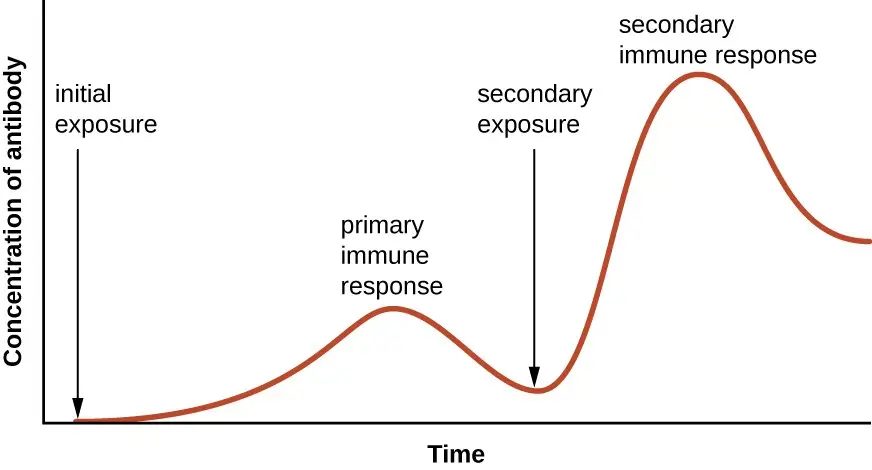Contents
Primary response definition
Primary Immune response is a type of immune reaction which occurs when the antigen comes in contact with the host’s immune system for the first time.
During the primary immune response activated effector T and B cells are produced which are helps to defend against the pathogen. Also Memory T and memory B cells are produced during this phase, in case if the same pathogen enters the organism again.
In primary response the naive B cells are stimulated by antigen, as result, they become activated, and form antibody-secreting cells, which produce specific antibodies for the antigen. The lag phase of the primary immune response is long, during this period the antibodies are produced against a particular antigen. Often the lag phase becomes as long as weeks or months.
During the primary immune response, the IgM antibody is produced. As the time spend, the antibody titer becomes undetectable. This type of immune response is generally occurring in lymph nodes and spleen.

Secondary Immune Response definition
The Secondary Immune Response is a type of immune response which occurs when the same antigen enters into the host’s body and initiates the stimulation of memory B cells, as a result, it leading to the formation of a huge number of specific antibodies that are previously formed in the primary response.
The length of lag phase in secondary immune response is shorter than that of the primary immune response, due to the presence of memory cells. During the secondary immune response mainly IgG antibody is produced along with a small amount of other antibody such as IgM, IgA, and IgE.

Differences between Primary and Secondary Immune Response
| Characteristics | Primary Immune Response | Secondary Immune Response |
| Definition | Primary immune response refers to any immune response of the immune system that includes the production of antibodies and/or cell-mediated immunity on exposure to antigen for the first time. | Secondary immune response refers to any immune response of the immune system that occurs when the immune system comes in contact with the same antigen for the second time. |
| Occurrence | This type of Immune Response mainly occurs in response to the primary contact of the antigen. | This type of Immune Response mainly occurs in response to the second and subsequent exposure to the same antigen. |
| Appearance | Primary Immune Response occurs in lymph nodes and spleen. | The Secondary Immune Response occurs in the bone marrow and then, in the spleen and lymph nodes. |
| Antibody Peak | Takes 7-10 days to reach the peaks of antibody level. | Takes 3-5 days to reach the peaks of antibody level. |
| Negative phase | No negative phase | Negative phase may occur |
| Affinity of Antibody | The antibody of Primary Immune Response contains a low affinity to their antigens. | The antibody of Secondary Immune Response contains a high affinity to their antigens. |
| Length of Lag Phase | The log phase of Primary Immune Response is Long (4-7 days). | The log phase of Secondary Immune Response is Short (1-4 days) |
| Responding Cells | The B cells and T cells are the main responding Cells in Primary Immune Response. | Memory B cells are the main responding Cells in Secondary Immune Response |
| Types of Antibodies | In the primary immune response, a large amount of IgM and a small amount of IgG are produced. | In Secondary Immune Response a large amount of IgG, a small amount of IgM, IgA, and IgE are produced. |
| Response Strength | This immune response is usually weaker than the secondary immune response. | The secondary immune response is stronger than the primary immune response. |
| Time Taken to Establish Immunity | It takes a longer time to establish the immune response. | It takes short time to establish the immune response. |
| Antibody level | In the primary immune response, the Antibody level declines to the point where it may be undetectable. | In the secondary immune response, the antibody level tends to remain high for longer. |
| Amount of Antibody | During the primary immune response, a few amounts of antibodies are produced. | During the secondary immune response, 100-1000 times more antibodies are produced. |
| Antibodies | Two types of antibodies are involved in primary immune response such as thymus-dependent and thymus-independent antibodies. | Here only one type of antibody is involved such as thymus-dependent antibodies. |
References
- https://onlinelibrary.wiley.com/doi/abs/10.1002/9780470015902.a0000947.pub2
- https://en.wikipedia.org/wiki/Immune_response
- https://microbenotes.com/differences-between-primary-and-secondary-immune-response/
- https://pediaa.com/difference-between-primary-and-secondary-immune-response/
- https://microbiologynotes.com/differences-between-primary-and-secondary-immune-response/
- https://microbeonline.com/differences-between-primary-secondary-immune-response/
Related Posts
- Difference Between Homologous Chromosomes and Sister Chromatids
- Difference between Monocarpic and Polycarpic Plants
- Differences Between Poisonous and Non-poisonous Snakes
- Differences Between Sensitivity, Specificity, False positive, False negative
- Anabolism vs Catabolism – Differences Between Anabolism and Catabolism











